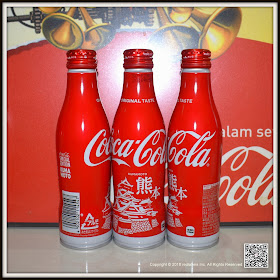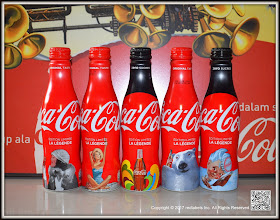Coca-Cola releases 5 new limited-edition bottles in Japan
While Pepsi tantalises our tastebuds with new and exciting limited-edition flavors in Japan, Coca-Cola keeps us on our toes with new and exclusive packaging.
Following on from the huge success of Coca-Cola’s beautiful sakura bottle, which was a hit during the hanami cherry blossom viewing season, the company has now announced it will be releasing five new bottles in Japan, to coincide with the summer holiday season.
Unlike the sakura bottle, which was available to purchase around the country, these five designs will be limited for sale in each of their corresponding regions.
First up is the Hokkaido bottle, which features well-known landmarks that can be found in the country’s northernmost prefecture. There’s the Sapporo Clock Tower, the Sapporo TV Tower, Hakodate’s Goryokaku Tower, and the statue of Dr William Smith Clark, an influential American professor who taught in Hokkaido in the late 1870s. The words “Hokkaido” can also be seen written in Japanese, along with an image of the prefecture and snowflakes, in reference to the area’s renowned snowfall. This bottle will be limited for sale in Hokkaido only.
Next up is the Tokyo bottle, which shows the famous city skyline, including Shinjuku high-rises, the Rainbow Bridge, and the iconic Tokyo Tower. This bottle will be limited for sale in regional and central Tokyo.
Moving down the country, we come to Kyoto, which features an image of a kimono-clad maiko looking out over an arched bridge and Daimonji-yama, a Kyoto mountain known for “Gozan Okuribi“, an event where the huge kanji character on the mountainside is set alight to celebrate the end of Obon, the festival of the dead. This bottle will be limited for sale in the Kansai region of Japan.
Next in line is Setouchi, which pays homage to the region’s famous floating torii gate, located at Itsukushima Shrine, and the Seto Ohashi Bridge that connects the mainland with the island of Shikoku over the Seto Inland Sea. This bottle will be limited for sale in the Shikoku and Chugoku regions of Japan.
The final bottle in the lineup is the Kumamoto edition, which gives pride of place to Kumamoto Castle, the city’s most revered structure, which suffered devastating damage following a series of earthquakes in 2016. This bottle will be available to purchase in Kyushu only.
The summer holiday period is one of the peak times for travel around Japan, when people return home to celebrate the important festival of Obon with family members. Travel in Japan always involves regional souvenir-giving, so these bottles will be vying for your attention at souvenir shops, convenience stores and supermarkets during your travels.
The Hokkaido and Tokyo bottles will be released on June 19, with the other four designs available in their respective regions from July 17. The slimline bottles will only be produced in limited numbers, and according to the company, they’ll only be available while stocks last.
Tokyo
Tokyo is the capital of Japan and one of its 47 prefectures. The Greater Tokyo Area is the most populous metropolitan area in the world. It is the seat of the Emperor of Japan and the Japanese government. Tokyo is in the Kantō region on the southeastern side of the main island Honshu and includes the Izu Islands and Ogasawara Islands.[9] Formerly known as Edo, it has been the de facto seat of government since 1603 when Shogun Tokugawa Ieyasu made the city his headquarters. It officially became the capital after Emperor Meiji moved his seat to the city from the old capital of Kyoto in 1868; at that time Edo was renamed Tokyo. Tokyo Metropolis was formed in 1943 from the merger of the former Tokyo Prefecture (東京府 Tōkyō-fu) and the city of Tokyo (東京市 Tōkyō-shi).
Kyoto
Kyoto (京都市) is a city located in the central part of the island of Honshu, Japan. It has a population close to 1.5 million. Formerly the Imperial capital of Japan for more than one thousand years, it is now the capital city of Kyoto Prefecture located in the Kansai region, as well as a major part of the Kyoto-Osaka-Kobe metropolitan area. Kyoto is also known as the thousand-year capital.
Hokkaido
Hokkaido, the northernmost of Japan’s main islands, is known for its volcanoes, natural hot springs (onsen) and ski areas. Rugged Daisetsuzan National Park is home to steaming, volcanic Mount Asahi. Shikotsu-Tōya National Park contains caldera lakes, geothermal springs and a Mount Fuji look-alike, Mount Yōtei. Popular ski resorts include Rusutsu, Furano and Niseko.
Setouchi
Setouchi is a city located in southern Okayama Prefecture, Japan. As of March 1, 2017, the city had an estimated population of 37,934, with 15,396 households and a population density of 300 persons per km². The total area is 125.51 km²
Kumamoto (熊本市 Kumamoto-shi) is the capital city of Kumamoto Prefecture on the island of Kyushu, Japan.
As of April 1, 2017, the city has an estimated population of 737,812 and a population density of 1,900 persons per km2. The total area is 389.53 km2.
Greater Kumamoto (熊本都市圏) had a population of 1,460,000, as of the 2000 census. As of 2010, Kumamoto Metropolitan Employment Area has a GDP of US$39.8 billion.It is not considered part of the Fukuoka–Kitakyushu metropolitan area, despite their shared border. The city was designated on April 1, 2012 by government ordinance.
Yokohama (Japanese: 横浜 Hepburn: Yokohama, pronounced [jokoꜜhama] ) is the second largest city in Japan by population, after Tokyo, and the most populous municipality of Japan. It is the capital city of Kanagawa Prefecture. It lies on Tokyo Bay, south of Tokyo, in the Kantō region of the main island of Honshu. It is a major commercial hub of the Greater Tokyo Area.
Yokohama's population of 3.7 million makes it Japan's largest city after the special wards of Tokyo. Yokohama developed rapidly as Japan's prominent port city following the end of Japan's relative isolation in the mid-19th century, and is today one of its major ports along with Kobe, Osaka, Nagoya, Hakata, Tokyo, and Chiba.




















































